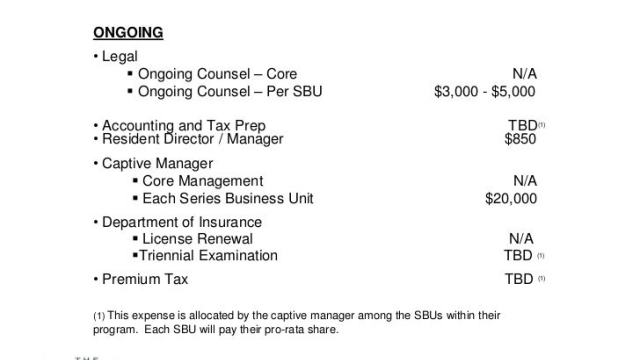
Unlocking Opportunities: Exploring the World of Captive Insurance
Welcome to the world of captive insurance, a fascinating and intricate realm that holds immense potential for businesses and organizations seeking to mitigate risks in a customized and cost-effective manner. At its core, captive insurance refers to a form of self-insurance where companies create their own insurance company to cover their specific risks. This alternative risk management strategy enables organizations to gain greater control over their insurance programs, tailor coverage to match their unique needs, and even potentially generate additional income.
One key aspect of captive insurance is the IRS 831(b) tax code, which provides an attractive tax advantage for small captives. Under this code, qualifying captives can elect to have up to $2.3 million in annual premium revenue exempt from federal taxation, making it an appealing option for businesses looking to optimize their financial structure. This provision has led to the rise of microcaptives, which are specialized captives typically formed by small and medium-sized companies to take advantage of the tax benefits outlined in the IRS 831(b) code.
Unlocking the opportunities offered by captive insurance requires a deep understanding of the regulatory landscape, risk management strategies, and prudent financial planning. As we delve further into this captivating world, we will explore the intricacies of captive insurance, discover the benefits it brings to various industries, and shed light on how organizations can effectively navigate this alternative risk management solution. So join us as we embark on this enlightening journey and uncover the possibilities that await in the realm of captive insurance.
Understanding Captive Insurance
Captive insurance refers to a unique form of risk management where an organization creates its own insurance company to cover its own risks. By doing so, the organization essentially "captivates" its insurance needs and gains more control over its coverage and costs.
One notable type of captive insurance is known as a microcaptive, specifically designed for small and medium-sized businesses. These microcaptives make use of a specific section of the IRS tax code, namely 831(b), which provides certain tax advantages for qualifying organizations.
Under the IRS 831(b) tax code, a microcaptive can elect to be taxed only on its investment income. This means that premiums received by the microcaptive from its parent company are not subject to tax, as long as they fall within certain limits and other requirements set by the IRS.
By establishing a captive insurance company, organizations can customize their coverage to match their specific needs, rather than relying solely on traditional insurance providers. This allows them to gain more flexibility and potentially reduce costs by eliminating unnecessary coverage. Additionally, captive insurance can provide businesses with unique opportunities for risk analysis, loss control, and claims management.
In summary, captive insurance, including the microcaptive variant under the IRS 831(b) tax code, offers organizations the chance to tailor their insurance coverage, potentially save costs, and gain greater control over their risk management strategies. It has become increasingly popular among businesses looking to unlock new opportunities in the ever-evolving landscape of risk management.
The Benefits of the 831(b) Tax Code
The 831(b) tax code offers several advantages for those involved in the captive insurance industry. One of the main benefits is the ability for small and mid-sized businesses to form a microcaptive insurance company and enjoy certain tax advantages. This tax code allows businesses to create a captive insurance company with a maximum premium income of $2.3 million annually, making it an attractive option for companies with moderate insurance needs.
One notable advantage of utilizing the 831(b) tax code is the ability to receive tax benefits on premiums received. Under this tax code, the premiums collected by the captive insurance company are not taxed as income. This allows businesses to retain more of their earnings, which can be reinvested or used for other business purposes. It provides an opportunity for companies to effectively manage their risk while also enjoying potential tax savings, making captive insurance a viable option.
In addition to the tax advantages, the 831(b) tax code also provides flexibility in terms of insurance coverage. As a captive insurance company, businesses have the freedom to customize their coverage based on their specific needs. This tailored approach allows companies to obtain insurance coverage that is specifically designed to address their unique risks and exposures. By having more control over their insurance program, businesses can better protect their assets and mitigate potential financial losses.
Overall, the 831(b) tax code offers a range of benefits for businesses exploring the world of captive insurance. Whether it’s the potential tax savings, flexibility in coverage, or the ability to effectively manage risk, this tax code provides an opportunity for businesses to unlock new opportunities and optimize their insurance strategy.

Exploring Microcaptive Insurance
Microcaptive insurance, also known as 831(b) captive insurance, is a form of self-insurance that has gained popularity among small to medium-sized businesses. Under the IRS 831(b) tax code, businesses can form their own insurance companies, referred to as microcaptives, to cover their specific risks. This innovative approach allows businesses to have more control over their insurance programs and potentially unlock various financial advantages.
One key advantage of microcaptive insurance is the potential for tax benefits. By forming a microcaptive, businesses can take advantage of the tax code’s provision that allows companies with annual premiums of $2.3 million or less to exclude these premiums from their taxable income. This can result in substantial tax savings and can be especially beneficial for businesses facing higher insurance costs in traditional commercial markets.
In addition to tax advantages, microcaptives provide businesses with tailored insurance coverage. Unlike traditional insurance policies, which may not fully meet a company’s unique needs, microcaptive insurance allows businesses to design their coverage specific to their risks and operations. This customized approach enables businesses to have greater control and flexibility over their insurance plans, ensuring that they are adequately protected.
However, it is worth noting that microcaptive insurance is a complex field that requires careful consideration and planning. It is important for businesses to consult with experienced professionals, such as captive insurance managers and tax advisors, to ensure compliance with regulatory requirements and maximize the benefits of this alternative insurance approach.
In conclusion, microcaptive insurance, operating under the IRS 831(b) tax code, offers businesses the opportunity to create their own insurance companies and customize their coverage. With potential tax advantages and the ability to tailor insurance plans to their specific needs, microcaptives can provide small to medium-sized businesses with a viable alternative to traditional commercial insurance. Nonetheless, businesses should approach microcaptive insurance with caution, seeking expert guidance to navigate the complexities of this field and unlock the full potential it offers.



